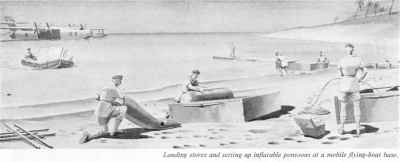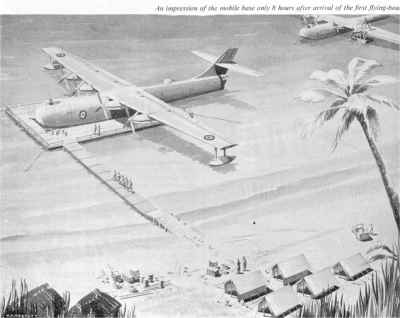The Flying Boat
A SUMMING UP
As
a weapon of defence, as a means of economic air transport and as the natural
medium for atomic propulsion, the modern flying-boat demands a place in
this second half-century of powered flight.
The fifth and final announcement in the flying-boat series sponsored by
Saunders-Roe appears overleaf. What is the summing-up in this case for the
water-based aircraft?
During the year in which the campaign has been running many fresh facts
have been displayed and many familiar fallacies have been exposed. It has
been shown that many of the misconceptions have their root in experience
of outdated aircraft.
It has been submitted that the large modern flying-boat can operate from
natural stretches of water such as the Solent . . . that it is able to operate
in almost any weather. . . that with jet or prop-jet engines it is as fast
as a comparable land plane and has a longer range.
It has been pointed out that three long- range flying-boats such as the
Princess, operating without pre-arranged facilities and able to accept re-routing
at short notice, could transport in a given period as many men as nine troopships.
Further, it has been asserted that the ocean-patrol flying-boat designed
today is able to operate with flexibility and independence in open-ocean
conditions.
There has been a discussion of the future and the coming of atomic power
for aircraft. The great weight of power plant and shielding and the high
wing loading at landing (due to negligible fuel consumption) both support
the proposition that atomic aircraft will have to be flying-boats.
In the United States where the significance of water-based aircraft is better
appreciated, flying-boats are in active production. The conclusion, surely,
is that with its present performance and .future possibilities, the flying-boat
continues to demand the attention of all in Britain who are concerned with
defence and economic air transport. We have at present great resources of
experience, knowledge and technical ability for the design of flying-boats.
We must either use or eventually lose these assets.
In the United States where the significance of water-based aircraft is better
appreciated,. .flying boats are in active production. The conclusion, surely,
is that with its present performance and .future possibilities, the .flying-boat
continues to demand the attention of all in Britain who are concerned with
defence and economic air transport. We have at present great resources of
experience, knowledge and technical ability for the design of flying-boats.
We must either use or eventually lose these assets.

The
great advance in the efficiency and performance of the flying-boat in recent
years has been accompanied by important progress in the development of operational
facilities and aids.
Thus the flying-boat is more than ever the most adaptable, versatile and
economic of all aircraft for long-range transport and general military duties.
Independent of costly and vulnerable prepared runways, the flying-boat has the key feature of flexibility - the ability to perform either from a mobile base in a remote part of the world or from a fixed base. Each of these operating conditions is met in its own way.

THE FIXED BASE
The permanent base, always less costly than the comparable landplane layout, can now have every feature for easy, rapid and economic operation. The pontoon docks can accommodate any size of aircraft at present contemplated, and reverse thrust and water rudders enable the aircraft to manoeuvre with precision under their own power.
Shore-mounted radar, radio communication and all other modem navigational aids are of course available
THE MOBILE BASE
Here the aim is for the flying-boats to be- initially, at least - entirely self-sufficient. They carry their own provisions, their own maintenance crews and equipment and, above all, their own inflatable pontoons. These are of unit construction - for easy assembly, dismantling and transportation
- and can be built up into floating platforms of any shape or size. Almost all maintenance can be carried out afloat. The aircraft's engine cowlings convert to built-in maintenance platforms and underwater inspection and repair can be carried out by members of the crew trained as frogmen.


| disclaimer | |
|
page modified |
|
|